Limitaciones de la procalcitonina como marcador único de sepsis neonatal de origen nosocomial
J.B. López Sastre , D. Pérez Solís , V. Roqués Serradilla , B. Fernández Colomer , G.D. Coto Cotallo , X. Krauel Vidal , E. Narbona López , M. García del Río , M. Sánchez Luna , C. de Alba Romero , M. Moro Serrano , A. Urbón Artero , E. Álvaro Iglesias , Á. Cotero Lav
Bol. Pediatr. 2007; 47 (201): 284 - 291
Introducción: Recientemente se ha sugerido que la procalcitonina (PCT) tiene capacidad discriminativa en el diagnóstico de sepsis neonatal. El objetivo de este estudio prospectivo multicéntrico es evaluar la utilidad de la PCT como marcador de sepsis neonatal de origen nosocomial. Pacientes y métodos: Se incluyeron 100 neonatos con sospecha de sepsis nosocomial de entre 4 y 28 días de vida ingresados en los servicios de neonatología de 13 hospitales de tercer nivel de España durante un período de 1 año. Se midió la concentración de PCT mediante análisis inmunoluminométrico. Se calculó la eficacia diagnóstica de la PCT en el momento de la sospecha de infección, a las 12-24 h y a las 36-48 h. Resultados: Se diagnosticaron 61 casos de sepsis nosocomial. Las concentraciones de PCT fueron superiores en los casos de sepsis nosocomial frente a los neonatos con sospecha de sepsis no confirmada. Los neonatos con sepsis por estafilococos coagulasa-negativos mostraron niveles de PCT más bajos que aquellos con sepsis nosocomial por otros agentes. Los puntos de corte óptimo para la PCT de acuerdo con las curvas ROC fueron 0,59 ng/mL en el momento de la sospecha de infección (sensibilidad 81,4%, especificidad 80,6%), 1,34 ng/mLa las 12-24 h (sensibilidad 73,7%, especificidad 80,6%) y 0,69 ng/mL a las 36-48 h (sensibilidad 86,5%, especificidad 72,7%) para el diagnóstico de sepsis de origen nosocomial. Conclusiones: La PCT mostró una moderada capacidad diagnóstica para la sepsis neonatal de origen nosocomial desde el momento de la sospecha de infección. Aunque por sí sola no sería suficientemente fiable, podría ser útil como parte de un chequeo de sepsis más completo. Abstract Background: It has recently been suggested that serum procalcitonin (PCT) is of value in the diagnosis of neonatal sepsis, with varying results. The aim of this prospective multicenter study was to assess the usefulness of PCT as a marker of neonatal sepsis of nosocomial origin. Methods: One hundred infants aged between 4 and 28 days of life admitted to the Neonatology Services of 13 acutecare teaching hospitals in Spain over 1-year with clinical suspicion of neonatal sepsis of nosocomial origin were included in the study. Serum PCT concentrations were determined by a specific immunoluminometric assay. The reliability of PCT for the diagnosis of nosocomial neonatal sepsis at the time of suspicion of infection and at 12-24 h and 36-48 h after the onset of symptoms was calculated. Results: The diagnosis of nosocomial sepsis was confirmed in 61 neonates. Serum PCT concentrations were significantly higher at initial suspicion and at 12–24 h and 36- 48 h after the onset of symptoms in neonates with confirmed sepsis than in neonates with clinically suspected but not confirmed sepsis. Optimal PCT thresholds according to ROC curves were 0,59 ng/mL at the time of suspicion of sepsis (sensitivity 81,4%, specificity 80,6%); 1,34 ng/mL within 12-24 h of birth (sensitivity 73,7%, specificity 80,6%), and 0,69 ng/mL within 36-48 h of birth (sensitivity 86,5%, specificity 72,7%). Conclusions: Serum PCT concentrations showed a moderate diagnostic reliability for the detection of nosocomial neonatal sepsis from the time of suspicion of infection. PCT is not sufficiently reliable to be the sole marker of sepsis, but would be useful as part of a full sepsis evaluation.
\N
\N
Artículo completo (PDF) (142 kb.)
- Neonatología
